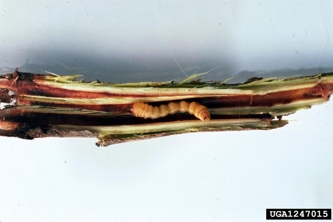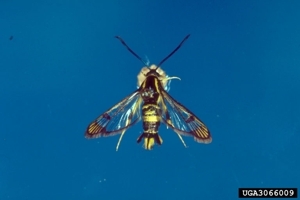Synanthedon scitula
The dogwood borer is one of the most serious pests of flowering dogwood in Connecticut. Very young trees are frequently killed and older ones are left reduced in vitality and with dead and dying branches. Other plants attacked by this insect include flowering cherry, apple, mountain ash, willow and oak.
Borer-infested trees begin to show swollen, knotty, calloused or gall-like areas on the trunk, just at or immediately below the ground surface or between the ground surface and the branches above. Injuries also occur at the union of the trunk and branches or smaller twigs and branches. Young dogwoods are attacked mostly at the crown.
Life History
The adult dogwood borers are small clear-winged moths which begin emerging in late May and may continue to do so until September. They reach their greatest abundance during late June and July. The moths mate and the females lay their eggs on bark, usually near an injury. The eggs hatch and the larvae, which are nearly white to light pink with a brown head capsule, wander about until they find an opening in the bark, since they cannot chew through uninjured bark. Upon finding an opening, they tunnel into the cambium of the older bark. They are not known to feed in sapwood. Borers in various stages of development can be found at the edge of bark wounds throughout the year. The larvae over winter in the tree and usually pupate there before emerging the following spring. Larval galleries will contain cocoons made up of silken threads that are covered by a layer of reddish frass (excrement).

Terry S. Price, Georgia Forestry Commission, Bugwood.org

James Solomon, USDA Forest Service, Bugwood.org
Control Measures
It is important to maintain the best possible health and vigor of dogwoods by fertilizing, pruning and by watering during dry seasons. Maintaining a mulch layer around (but not up against) the plant to aid in keeping the soil cool and moist should help in keeping the plant healthy. Undiluted white latex paint applied to the lower trunk prior to egg-laying can reduce infestations.
Avoid wounding the trunks and branches. Lawn mower and line trimmer injuries afford excellent places for borers to enter. Mulch around the base to avoid these injures.
A fine wire can be inserted into the entry hole and pushed up the feeding channel to kill the larva. Recent research has found that beneficial nematodes can be an effective control measure for the dogwood borer. Natural predators of the larvae include woodpeckers, nuthatches and other birds. The adults may be eaten by birds, bats, and spiders.
The beneficial entomophagous nematode Steinernema carpocapsae may control this pest. The nematodes are suspended in water at a rate of 500 per square inch of bark. This is sprayed directly onto the bark of the tree during the larval stage of the borer in late August. Follow all directions
Pyrethrin is labeled for use by the homeowner against dogwood borer. Since dogwood borer adults may be present from late April through July, several applications may be needed for good control. Begin treatment in early May and repeat four times at three-week intervals. Thoroughly spray the trunk, major branches and any wounds on the bark. Read and follow all label instructions and precautions.
Despite good cultural practices, pests and diseases at times may appear. Chemical control should be used only after all other methods have failed. For pesticide information please call UConn Home and Garden Education Center or your local cooperative extension office.
The UConn Home & Garden Education Center supports UConn Extension’s mission by providing answers you can trust with research-based information and resources. For gardening questions, contact us toll-free at (877) 486-6271, visit our website at homegarden.cahnr.uconn.edu, or reach out to your local UConn Extension center at cahnr.uconn.edu/extension/locations.
Revised by the UConn Home and Garden Education Center, 2016.